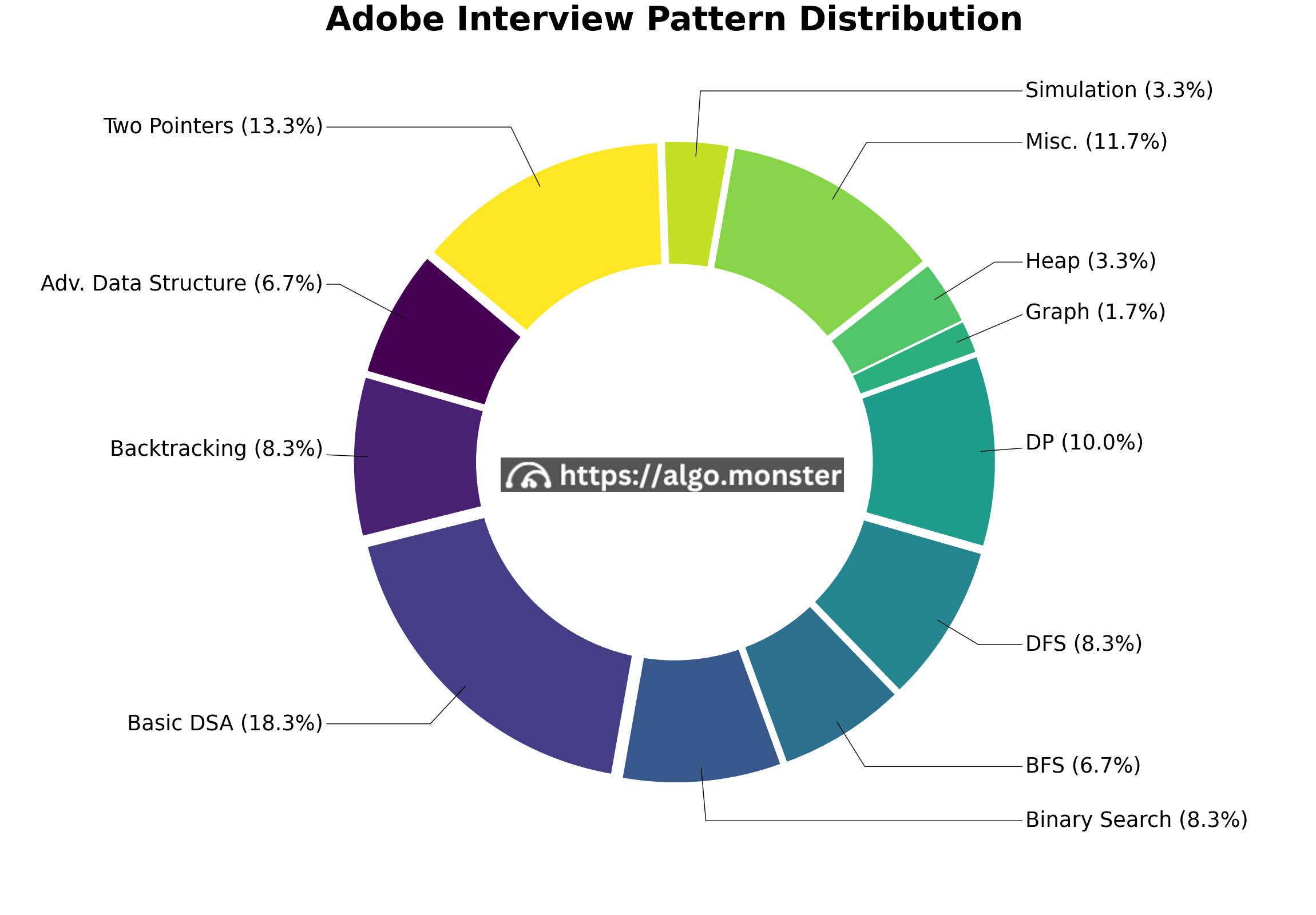Adobe Interview Questions: What to Expect and How to Prepare
Refreshed monthly, last refreshed on November 6, 2025
Frequently Asked Adobe Interview Questions
Your Progress
0 / 54By Pattern
By Difficulty
Adobe Interview Process
Adobe's interview process begins with a thorough resume screening, targeting candidates with strong backgrounds in software engineering. Applicants might face Online Assessments (OA) focusing on coding and problem-solving skills. This stage is designed to evaluate technical knowledge comprehensively.
Following the initial assessments, candidates typically undergo one to two phone interviews before advancing to the onsite rounds. The onsite interviews, which are more intensive, typically involve multiple rounds with both technical and behavioral questions. The overall difficulty level is considered to be high, aligning with Adobe’s status as a leading software company.
Initial Screen
At Adobe, the initial screening process begins with resume scrutiny, focusing on relevant experience and technical prowess. Typically, a recruiter will review your application within two weeks of submission.
Following the resume review, successful candidates often face Online Assessments (OAs), designed to evaluate coding skills and problem-solving capabilities, before moving to a preliminary screening call.
Phone Screen
At Adobe, the interview process typically involves one or two phone screens. These initial calls focus on assessing the candidate's technical skills and problem-solving abilities through coding questions and discussions about past projects and experiences.
During phone screens, candidates may also face questions related to Adobe's core values and how their professional goals align with the company's objectives. It's a crucial step to gauge both technical prowess and cultural fit within Adobe's innovative environment.
Onsite Rounds
At Adobe, onsite interview rounds typically consist of three to five separate interviews. These sessions may cover coding, system design, and behavioral aspects. Each interview generally lasts about an hour, focusing intensively on both technical skills and cultural fit.
Onsite interviews at Adobe are rigorous. Candidates can expect to engage in complex coding problems, detailed system design discussions, and behavioral questions that explore adaptability, problem-solving, and teamwork. Prepare to demonstrate how you can contribute to Adobe's innovative environment.
Final Rounds, Negotiation, Offer
After the final interview rounds at Adobe, candidates may undergo team matching and meetings with senior executives. Offers are then extended and negotiations on terms can take place.
Adobe Technical Interview Questions and Patterns

At Adobe's software engineering interviews, applicants can expect a diverse array of coding problems mainly revolving around Dynamic Programming, Basic DSA, and Two Pointers. While these areas dominate, candidates should also be prepared for less frequent, yet challenging problems involving Graphs and Advanced Data Structures. Mastery in these key areas could potentially give applicants a competitive edge during the technical assessment phase of the interview.
Sample Classical Behavioral Questions and Answers
Tell me about a time when you had to learn a new tool or technology quickly to complete a project.
- Discuss a specific project, the challenges faced, and how quickly adapting to new technology led to successful project completion. Emphasize abilities to learn on-the-fly and innovate under pressure.
Describe a situation where you had to deal with a difficult bug in your code. How did you resolve it?
- Highlight a methodical approach to problem-solving, use of debugging tools, persistence, attention to detail, and teamwork if others were involved in the solution process.
Can you talk about a project where you had to collaborate with multiple teams? What challenges did you face and how did you overcome them?
- Focus on communication skills, the ability to work interdependently across diverse teams, and conflict resolution skills. Mention specific instances where coordination was key to overcoming project roadblocks.
Sample Teamwork Behavioral Questions and Answers
Describe a time when you had to collaborate with a team to solve a complex problem. What was your role and how did the team arrive at a solution?
- Outline the problem, emphasizing the complexity. Detail your specific role, focusing on leadership or collaboration skills. Explain the solution process and the final outcome, highlighting how teamwork was instrumental.
Can you give an example of when you had to integrate feedback from multiple sources into your project? How did you ensure all voices were heard?
- Discuss collecting and managing feedback, perhaps using tools or methods like regular meetings or collaborative software. Emphasize how integrating diverse feedback improved the project outcome and your own learning process.
Adobe is known for its innovation in software solutions. Can you talk about a time when you worked in a team to create a new or improved software feature?
- Reflect on a project that required innovative thinking. Explain the team's approach to brainstorming and development, and how contributions were managed and implemented. Mention any Adobe products or tools used, showing familiarity with their ecosystem.
Sample Role Specifc Behavioral Questions and Answers
Tell me about a time when you had to learn a new programming language or technology to complete a project. How did you approach the learning process?
- Highlight the ability to rapidly acquire new skills. Discuss the strategies used for learning, such as online courses, reading documentation, or hands-on practice, and how this contributed to the project's success.
Describe a situation where you had to collaborate with multiple teams on a software project. How did you handle the communication and integration of different ideas?
- Emphasize teamwork and clear communication. Mention specific tools or methods used to facilitate teamwork and integrate diverse ideas, such as Agile practices or regular meetings, showcasing your ability to work effectively in collaborative environments.
Adobe prides itself on innovation. Can you share an experience where you had to think out-of-the-box to solve a technical problem?
- Focus on creativity and innovation. Describe a scenario where conventional solutions were inadequate and how you devised a novel approach. Highlight how this innovative solution positively impacted the project, underscoring alignment with Adobe’s values of creativity and innovation.